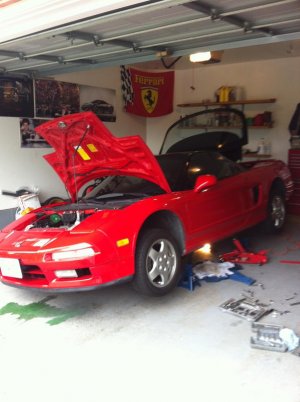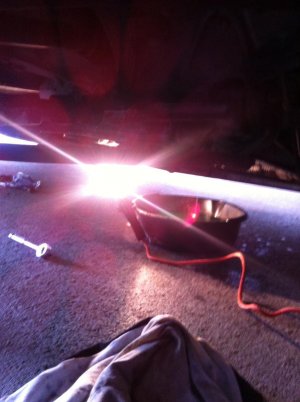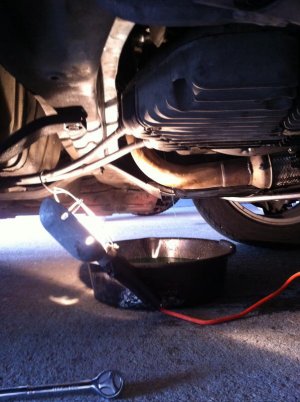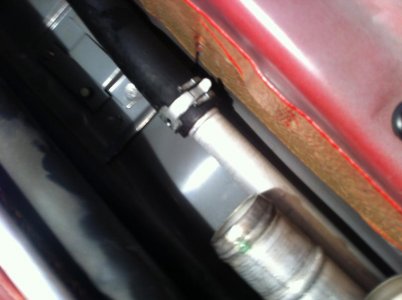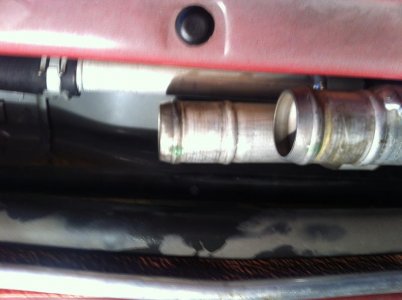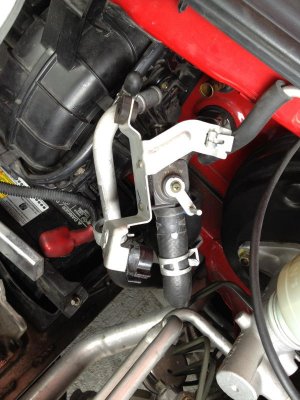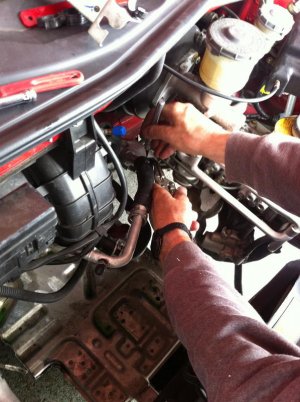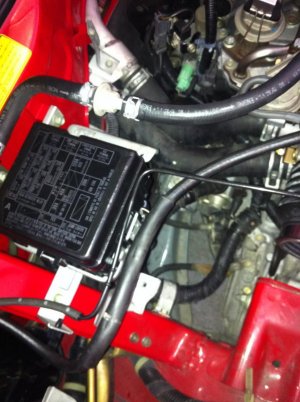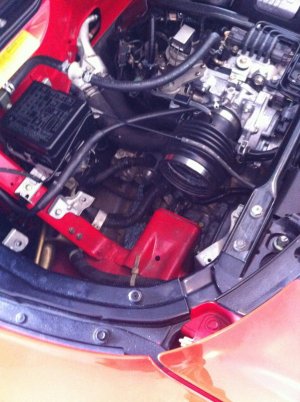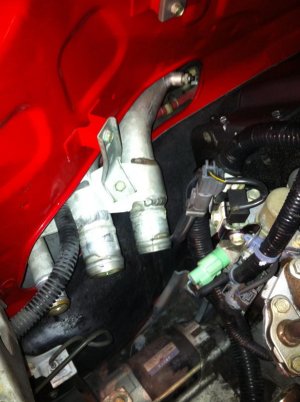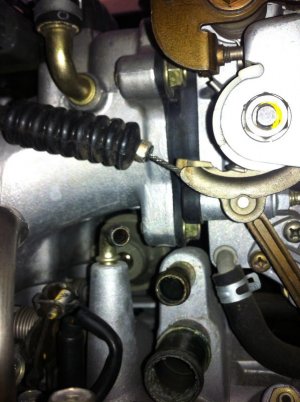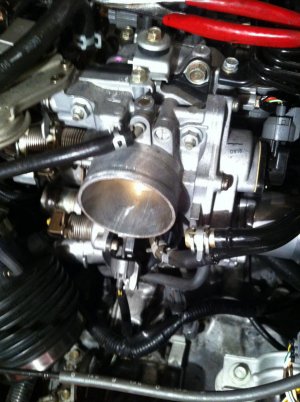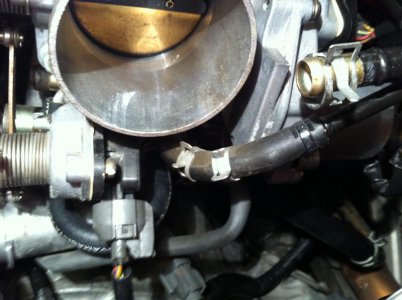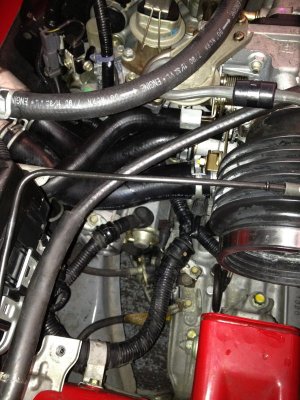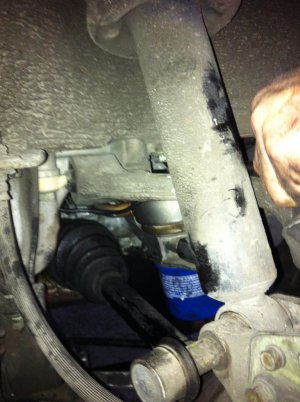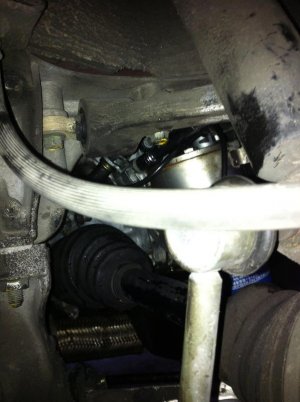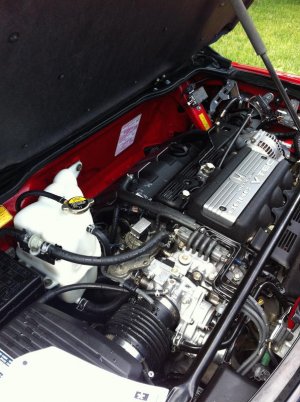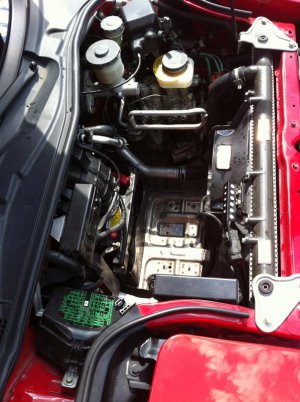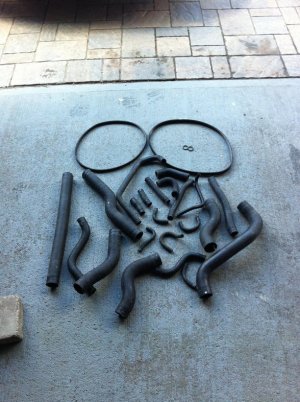I know this has been discussed previously on Prime, but I thought I would provide some feedback / insight into my adventures of replacing all 22 coolant hoses on my 1991 NSX in case anyone is considering doing this job in the near future. The car had the originals and thus were over 20 years old. I figured I'd better change them out before something bad happens.
One thing I should point out is that before doing this job, I called around some local shops to see how much they would charge to replace the hoses. Most were reluctant to do this kind of work, making me suspicious of the quality of work. As such, I decided to do it myself.
I ordered the kit from Dali along with a new alternator and A/C belt. The entire procedure took me 2 full days to complete - a bit longer than most here on Prime, but I wanted to take my time and make sure I was doing a good job. I was quite bruised, sore and cut up from doing the work, especially my back and leg muscles - must have been all the bending and contortionist positions I executed.
All in all, the job wasn't too difficult technically, but extremely time consuming. A lot of patience is required to do this kind of work and I can understand why a shop would charge $1,500 - $2,000. For those of you looking to do it yourself, if you have the time and patience, then go for it. The manual is detailed enough to pinpoint all the hoses that need replacing, along with the draining and bleeding procedures involved. Otherwise, if you're not comfortable, then bring it to a shop to get done. I consider myself a novice mechanic and was able to do this, so for those of you on the fence, it is entirely possible. Just bring time and patience, and the right tools, with you.
Some interesting tidbits from doing this work:
[FONT=Courier, Monospaced] - The most important tools for doing this job include a razor sharp cutting knife and various sized pliers (especially 12” long vise grips and angled needle nose pliers)[/FONT]
[FONT=Courier, Monospaced]
- I’d say only 3 of the 22 coolant hoses came off by themselves. The
rest had to be cut off with a knife.[/FONT]
[FONT=Courier, Monospaced] [/FONT]
[FONT=Courier, Monospaced]- I was surprised at how good a shape the original hoses were in. I did hear some crunching noises while taking some of them off, but most did not. These hoses are of very high quality for sure.[/FONT]
[FONT=Courier, Monospaced]
[/FONT]
[FONT=Courier, Monospaced] - Putting the hoses on was a pain. These hoses go on extremely tight. KY jelly came to the rescue here – I knew there were other uses for KY other than…….
[/FONT]
[FONT=Courier, Monospaced]
[/FONT]
[FONT=Courier, Monospaced] - I couldn’t believe how much coolant these cars hold. I thought I
had thoroughly drained the system, but always found residual coolant
in the hoses, which made for a messy job. Also, I never realized how sweet coolant tastes!![/FONT]
[FONT=Courier, Monospaced]
- The clamps Honda uses on the hoses work really well, but are
potentially dangerous. I had one let go on the vise grip and snapped
onto my finger, which is now purple.[/FONT]
[FONT=Courier, Monospaced]
- I would say the most difficult hoses to get to were the 3 under the
car and 2 going to the oil cooler. Patience is required to get to the hoses on the oil cooler, and I followed the advice here on Prime to remove the cooler entirely and do one hose at a time. Many thanks!![/FONT]
After finishing the job, it was time to fill the system up with
coolant. I followed the bleeding procedure in the manual and tried
the “raise the rear of the car” trick advertised here on Prime.
Raising the rear didn’t work for me as it “screwed up” the bleeding
procedure, so I dropped it and did it via the manual. When I started
the engine, I noticed the temperature gauge began to climb past the
halfway mark and saw steam and bubbling from the expansion tank. I
figured there was still air in the system somewhere, so I shot it off,
bled the system again and started it up. This time no problem. Took if
for a drive and all was fine.
So far so good. I haven’t noticed any leaks and am keeping my fingers
crossed that none will happen.
Hope this helps those considering doing this job. I'll try posting pics here of my work.
One thing I should point out is that before doing this job, I called around some local shops to see how much they would charge to replace the hoses. Most were reluctant to do this kind of work, making me suspicious of the quality of work. As such, I decided to do it myself.
I ordered the kit from Dali along with a new alternator and A/C belt. The entire procedure took me 2 full days to complete - a bit longer than most here on Prime, but I wanted to take my time and make sure I was doing a good job. I was quite bruised, sore and cut up from doing the work, especially my back and leg muscles - must have been all the bending and contortionist positions I executed.
All in all, the job wasn't too difficult technically, but extremely time consuming. A lot of patience is required to do this kind of work and I can understand why a shop would charge $1,500 - $2,000. For those of you looking to do it yourself, if you have the time and patience, then go for it. The manual is detailed enough to pinpoint all the hoses that need replacing, along with the draining and bleeding procedures involved. Otherwise, if you're not comfortable, then bring it to a shop to get done. I consider myself a novice mechanic and was able to do this, so for those of you on the fence, it is entirely possible. Just bring time and patience, and the right tools, with you.
Some interesting tidbits from doing this work:
[FONT=Courier, Monospaced] - The most important tools for doing this job include a razor sharp cutting knife and various sized pliers (especially 12” long vise grips and angled needle nose pliers)[/FONT]
[FONT=Courier, Monospaced]
- I’d say only 3 of the 22 coolant hoses came off by themselves. The
rest had to be cut off with a knife.[/FONT]
[FONT=Courier, Monospaced] [/FONT]
[FONT=Courier, Monospaced]- I was surprised at how good a shape the original hoses were in. I did hear some crunching noises while taking some of them off, but most did not. These hoses are of very high quality for sure.[/FONT]
[FONT=Courier, Monospaced]
[/FONT]
[FONT=Courier, Monospaced] - Putting the hoses on was a pain. These hoses go on extremely tight. KY jelly came to the rescue here – I knew there were other uses for KY other than…….
[/FONT]
[FONT=Courier, Monospaced]
[/FONT]
[FONT=Courier, Monospaced] - I couldn’t believe how much coolant these cars hold. I thought I
had thoroughly drained the system, but always found residual coolant
in the hoses, which made for a messy job. Also, I never realized how sweet coolant tastes!![/FONT]
[FONT=Courier, Monospaced]
- The clamps Honda uses on the hoses work really well, but are
potentially dangerous. I had one let go on the vise grip and snapped
onto my finger, which is now purple.[/FONT]
[FONT=Courier, Monospaced]
- I would say the most difficult hoses to get to were the 3 under the
car and 2 going to the oil cooler. Patience is required to get to the hoses on the oil cooler, and I followed the advice here on Prime to remove the cooler entirely and do one hose at a time. Many thanks!![/FONT]
After finishing the job, it was time to fill the system up with
coolant. I followed the bleeding procedure in the manual and tried
the “raise the rear of the car” trick advertised here on Prime.
Raising the rear didn’t work for me as it “screwed up” the bleeding
procedure, so I dropped it and did it via the manual. When I started
the engine, I noticed the temperature gauge began to climb past the
halfway mark and saw steam and bubbling from the expansion tank. I
figured there was still air in the system somewhere, so I shot it off,
bled the system again and started it up. This time no problem. Took if
for a drive and all was fine.
So far so good. I haven’t noticed any leaks and am keeping my fingers
crossed that none will happen.
Hope this helps those considering doing this job. I'll try posting pics here of my work.


